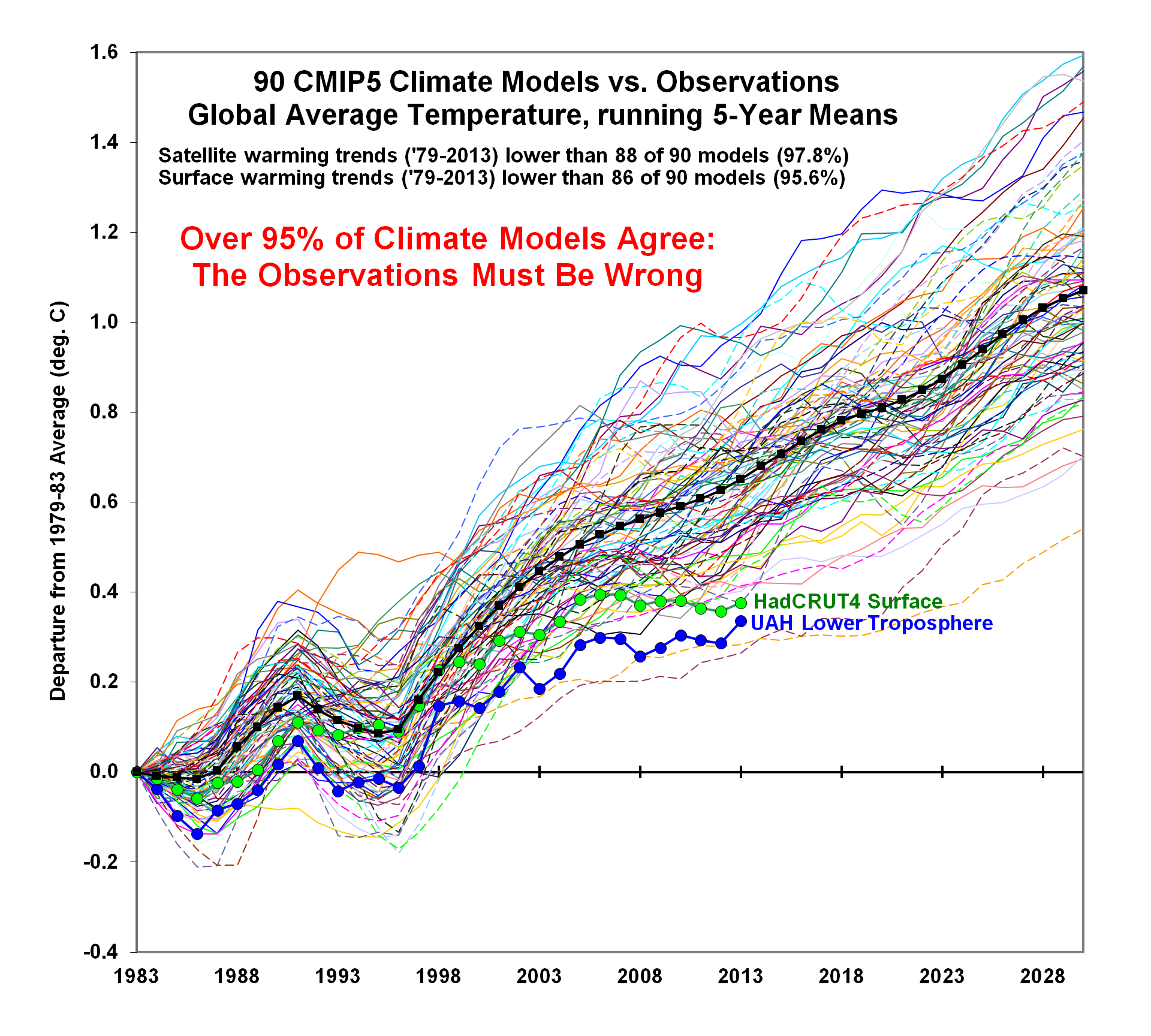The authors claim based on 20th century observations that ECS is "2.3 K..., near the bottom of the IPCC's likely range of 1.5-4.5 K." But, no worries, the authors state all we have to do is fudge the forcing from aerosols and ozone by increasing their "efficacy" 33% greater: "Increasing the aerosol and ozone efficacy to 1.33 [instead of 1.0] increases the ECS to 3.0 K (1.9-6.8 K), a value in excellent agreement with other estimates. Forcing efficacy therefore provides a way to bridge the gap between the different estimates of ECS."
Folks, this is just plain cheating & fudging. One Watt per meter squared forcing from CO2 is the same as 1 Watt per meter squared forcing from aerosols or ozone, not 1.33 Watts per meter squared. You can't just multiply selected forcings by a 1.33 fudge factor to make observations "bridge the gap" with overheated climate models.
The co-author of this paper Andrew Dessler has a long and sordid history of making highly questionable assertions in support of the climate scam, and this is yet another blatant example. He finds climate sensitivity to CO2 based on observations is "near the bottom of the IPCC's likely range," and does so even with the false assumption that all 20th century warming was anthropogenic, then throws that low estimate away by inventing a new name for his fudge factor called "forcing efficacy" to bump climate sensitivity up to the magic IPCC mean estimate of 3C per CO2 doubling.
The impact of forcing efficacy on the equilibrium climate sensitivity
J.R. Kummer and A.E. Dessler
Estimates of the Earth's equilibrium climate sensitivity (ECS) from 20th-century observations predict a lower ECS than estimates from climate models, paleoclimate data, and interannual variability. Here we show that estimates of ECS from 20th-century observations are sensitive to the assumed efficacy of aerosol and ozone forcing (efficacy for a forcer is the amount of warming per unit global average forcing divided by the warming per unit forcing from CO2). Previous estimates of ECS based on 20th-century observations have assumed that the efficacy is unity, which in our study yields an ECS of 2.3 K (5%-95%-confidence range of 1.6-4.1 K), near the bottom of the IPCC's likely range of 1.5-4.5 K. Increasing the aerosol and ozone efficacy to 1.33 increases the ECS to 3.0 K (1.9-6.8 K), a value in excellent agreement with other estimates. Forcing efficacy therefore provides a way to bridge the gap between the different estimates of ECS.
The impact of forcing efficacy on the equilibrium climate sensitivity
J.R. Kummer and A.E. Dessler
Estimates of the Earth's equilibrium climate sensitivity (ECS) from 20th-century observations predict a lower ECS than estimates from climate models, paleoclimate data, and interannual variability. Here we show that estimates of ECS from 20th-century observations are sensitive to the assumed efficacy of aerosol and ozone forcing (efficacy for a forcer is the amount of warming per unit global average forcing divided by the warming per unit forcing from CO2). Previous estimates of ECS based on 20th-century observations have assumed that the efficacy is unity, which in our study yields an ECS of 2.3 K (5%-95%-confidence range of 1.6-4.1 K), near the bottom of the IPCC's likely range of 1.5-4.5 K. Increasing the aerosol and ozone efficacy to 1.33 increases the ECS to 3.0 K (1.9-6.8 K), a value in excellent agreement with other estimates. Forcing efficacy therefore provides a way to bridge the gap between the different estimates of ECS.

Anyone who has used computer modeling in any field knows how easy it is to fudge the results, and how difficult it is to say no when the stakes are high in prestige and money.
ReplyDeleteForget arguing. I agree. The science is settled. Fine. Great.
ReplyDeleteDefund it. All of it. Every Federal dollar.
We don't fund settled science.
Comment from Nic Lewis who has published research on this topic -
ReplyDeleteKummer & Dessler seem to have performed their basic calculations improperly.
They claim that the AR5 forcing time series are referenced to the late 19th century, and therefore deduct from the temperature time series the 1880-1900 average temperature. But the AR5 forcing time series are, as stated in Table 8.6 (which they cite), referenced to 1750. They should therefore have likewise deducted the 1880-1900 average forcing from the forcing time series.
Upon making this correction, I calculate that Kummer & Dessler's basic estimate of climate sensitivity should be (taking the median) 1.5 C, not 2.3 C.
I dispute their/Shindell's contention that aerosols and ozone have an efficacy substantially above one. But even taking their high case of an efficacy for them of 1.5 would only increase the climate sensitivity median estimate to 1.75 C, not to 3.5 C as they calculate.
This appears to be an unscientific attempt to undermine the robust energy budget evidence for climate sensitivity being low. It is appalling that the paper has been accepted for publication by GRL.
Thanks very interesting is this a comment from WUWT or some other source?
Deletehttp://www.bishop-hill.net/blog/2014/5/8/dessler-rebuts.html
DeleteWhere is that comment? Do you remember?
Deletehttp://troyca.wordpress.com/2014/05/09/on-forcing-enhancement-efficacy-and-kummer-and-dessler-2014/
ReplyDelete